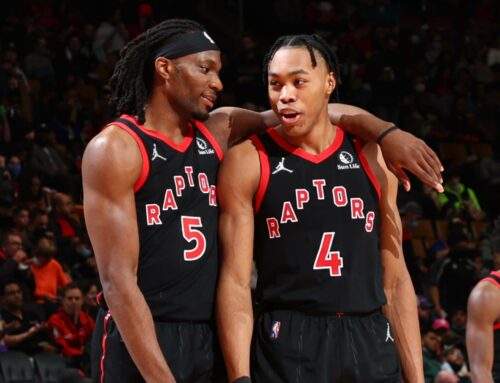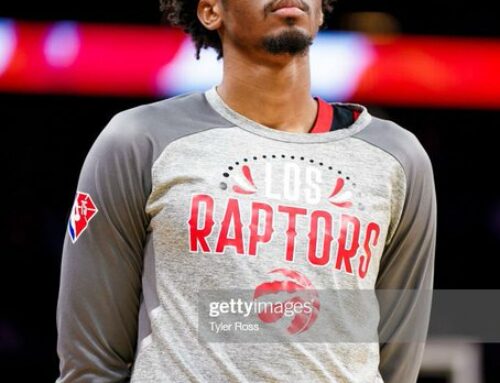***This post is the fifth of a series discussing the importance of shooting and developing a good shot.
- Read Part I explaining shooting’s value in modern basketball.
- Read Part II to learn how important your legs are to shooting.
- Read Part III to see what I consider essential shooting principles.
- Read Part IV exploring the shooting motion and what to do with your arms.
The hands.
The bouquet’s rose. The cruise ship’s rudder. The fruit cup’s pineapple.
The hands are the defining factor of a basketball shot. They create its direction, loft, finesse, and spin.
Think of shooting like building a house.
Your legs are the foundation. They provide stability and strength. Without them, your house shifts or crumbles; your shot is weak and slow. Your arms are the walls and the roof giving structure and form. Your hands, they’re the plumbing, the electricity, and the flat screen TV. They transform a mere toss into an actual basketball shot.
Of course, every house is different. We all have unique bodies and each body part its own mechanics. What appears natural to one shooter may feel entirely alien to another.
You can’t tell your body to do something it is physiologically incapable of doing. No matter how many times I think I can go for a fourth helping at a buffet, I never get past the third plate.
We talked a lot about a shooter’s individuality in Part III and IV, but let me remind you, once again, that, even though I am suggesting how a shooting form should ideally look, there is no one right way.
There are good mechanics, but there will always be variation within them.
What is an Ideal Shot?
I suppose, I should mention what our ultimate objective is here. It’s to put the ball in the hoop, obviously. But what is the best way to do that?
A good shot likely has a high arc, is straight, and with lots of backspin, but that begs the questions: How high? How far into the hoop (I’ll explain this in a second)? And how much backspin?
Well, it should come as no surprise to you that there is a lot of basic science and advanced research to answer these questions.
1. (Not Too) High Arc
Some shooters have higher arcs than others, but an optimally-arced shot gives the ball the best trajectory (ugh physics) of going into the hoop. If you miss and hit the rim, the height of the ball (along with the backspin) increases the chances of it still going in.

Researchers out of North Carolina State University used a computer simulation model for free throw shooting and concluded that, generally speaking, shooters should release the ball as high as they can without compro
mising their shot mechanics. Of course, the further out you are from the basketball hoop, the flatter your release will probably be. More specifically, Noah Shooting System, which uses sensor technology to track shot paths, determined that a shot arriving at the hoop on a 45-degree angle has the best results.
2. Keep it Straight

This is obvious. You want the ball to travel directly from where you launched the ball to where the hoop sits. But where, exactly? Those same NC State researchers found that aiming the ball towards the back of the rim had the best results. Noah Shooting System also confirms NC State’s finding that the best place for the centre of the ball to land is 11 inches from the front of an 18-inch rim.
3. Lots of Backspin
A ball travelling towards a rim without backspin bounces off at the same trajectory it lands (right into the backboard and awayyyyy). Meaning, if your shot is not perfect each time, the ball is going to be pinging all over the damn place.
Backspin, however, uses friction (ugh more physics) to slow the ball down on the rim. The force of the spinning ball resists the ball bouncing up and away from the rim. So when you “miss” at first, the ball is more likely to bounce upwards or more lightly forward to give you a second or third or fourth bounce (I still get shivers). The further away your shot, the sharper the trajectory and the more important spin is. The faster the backspin, the “softer” the shot.
For free throws, NC State found that the ball should travel at least three full rotations for optimal backspin. This will be important for what we do with our fingers (stay tuned)!
To recap: A “perfect” basketball shot has a pretty high arc (not too high), travels towards the back of the rim, and is juiced with lots of backspin.
Okayyyyy no more science.
Where to Place Your Hands – The “T” Shape
Our hands want to be in a position where the Shooting Hand is doing all the talking and the Guide Hand shuts-up. Ideally, this means your Shooting Hand is under the ball – putting it in the best place to get off a straight, high-arcing shot. Your Guide Hand is then squarely on the side of the ball.
Hint: You can check your hand positions by seeing if your thumbs create a “T”. Your Guide-Hand thumb being the “top” of the “T” and Shooting-Hand thumb the “stem”. There should be about an inch between your two thumbs; they should not be touching.
What to Do with Your Shooting Hand
Now, not all shooters can get their hands under the ball at the start of their shooting motion, or what I call the Starting Pocket, to create that “T”.
Test: Hold your shooting arm out straight in front of you, hand facing the ground. Bend your hand back towards you. Can you bend your hand straight back (almost 90 degrees) without your arm moving or your hand twisting? Yes? You likely have the flexibility to put your hand under the ball. No? You will probably have to move your Shooting Hand outside or in front of the ball (see below) or keep your hand under and angle your shooting elbow out a bit.
If your wrist does not draw straight back, no problem. Some of the best shooters in the world have their hands on different parts of the ball. What matters, when it is all said and done, is that your release point ends with a high, straight follow-through towards the hoop.
Hint: Keep an eye on the ball as it travels. Is it spinning straight (back spin) or is it spinning diagonally or sideways?
1. Shooting Hand Behind the Basketball
Place your hand behind the basketball facing straight towards the hoop. This creates the traditional “T”.

Benefit: This position forces your wrist to almost immediately lock, lessening ball movement in your shot and shortening the speed of your shot mechanics.
Drawback: For some players, placing your hand directly behind the ball causes the elbow to pop out too far like a chicken wing. That causes a whole list of problems that we want to avoid.
2. Shooting Hand on Top of the Basketball
Place your hand further ahead of the basketball still making sure your hand is facing parallel to the hoop.

Benefit: Players are able to keep their elbow aligned by bringing the arm further up the ball.
Drawback: Having the hand on top of the basketball requires a shooter to lock their wrist under the ball while bringing the ball up to shoot. This can break your shot into two motions and create a hitch: the player pauses their shooting motion to lock their wrist under the ball and then moves into their release.
Hint: Avoid hitches by locking your wrist early in the shooting motion before you reach your Shooting Pocket.
3. Hand on the Side of the Basketball
Place your hand further towards the side of the basketball where the palm of your Shooting Hand is starting to face the palm of your Guide Hand. As you go to shoot, spin the ball gently into your Shooting Hand enabling it to slide under the ball.

Benefit: It relieves tension between your wrist and your elbow and enables you to get your hand underneath the ball. It also flows naturally into your release. Also, like, the best shooter ever does it, so, there’s that.
Drawback: There is extra motion involved, which leaves more room for error and wasted time. If you do not spin the ball properly in your hand, lots of mechanical uh-ohs arise.
What to Do with your Guide Hand?
Like I said, the Guide Hand is the silent partner. It supports the shot, but does not partake – for the most part – moving minimally if at all.
At the beginning of your shot, the Guide Hand should sit at the side of the ball, and at the end of your shot, the four fingers of your Guide Hand should face one of two ways:
straight up

or slightly forward

Either one works so long as you keep the ball balanced and undisturbed. Anything else and we have problems.
Bad habits can include:
- “Not on the Side”: Guide Hands at the front, top, or back of ball is going to cause instability problems. Keep it on the side.
- “Hard Grip”: Guide Hands are there to guide, gently. Squeezing the ball will interrupt the fluidity of the shot.
- “Assisted Shooting”: To add more strength (especially for younger players), shooters have their Guide Hand turn in and push the ball, affecting spin and accuracy. Find the power in your legs instead.
- “Thumb Shooting”: Same problem as assisted shooting, but in this case it is only the thumb doing the pushing. Still bad. Aside: Kyrie Irving does this, but, still, not encouraged

- “Pull Away”: Shooters overprotect the Shooting Hand by pulling their Guide Hand away as they shoot. That hinders consistency and affects accuracy.
- “Hold Too Long”: Shooters keep their Guide Hand on the ball while following through. Instead, keep your Guide Hand at the ball only until the “flick of the wrist” into the release – let your Shooting Hand go the final bit alone.
Lots to take in. And, at first, not entirely clear when there is so much variability. I used to think THERE IS ONLY ONE WAY TO PUT YOUR HANDS ON THE BALL.
But that was too strict.
It is truly about what will give you the most comfort and consistency in your shot. Something you can only discover through much repetition and tracking. If your percentages are low and range limited, use these principles to adjust. If you’re hitting everything without a hiccup – then keep shooting the good stroke.





